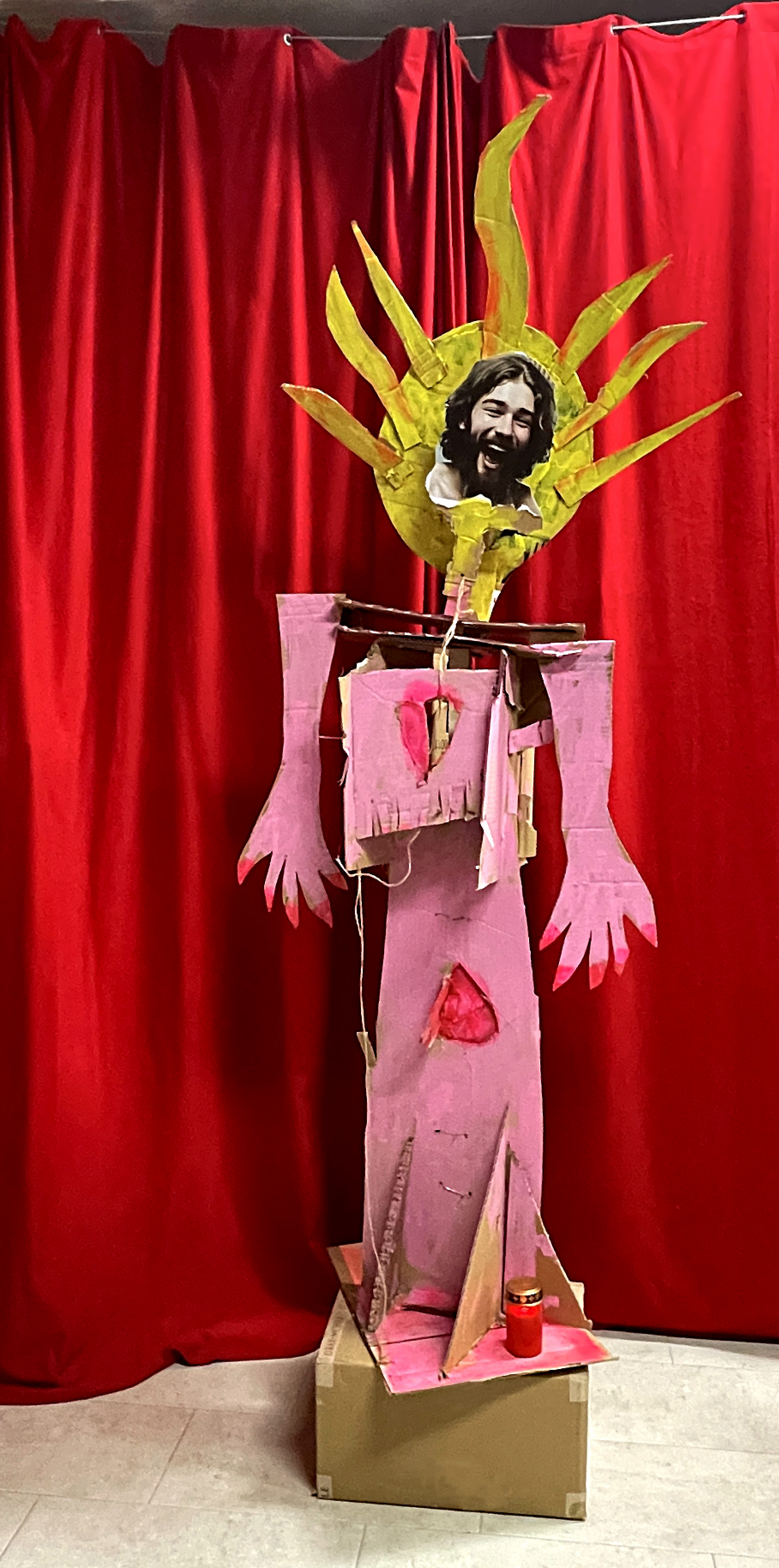
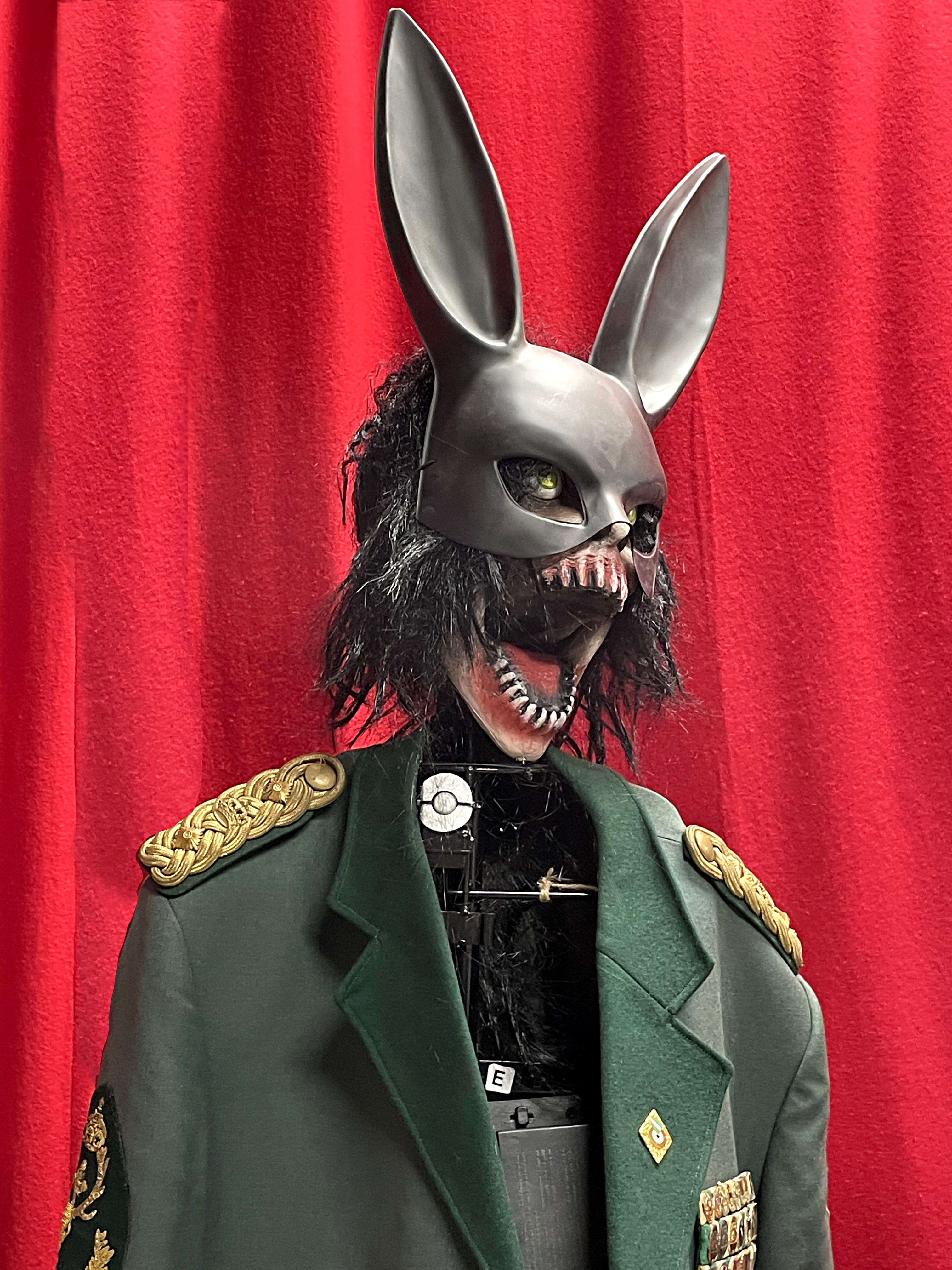
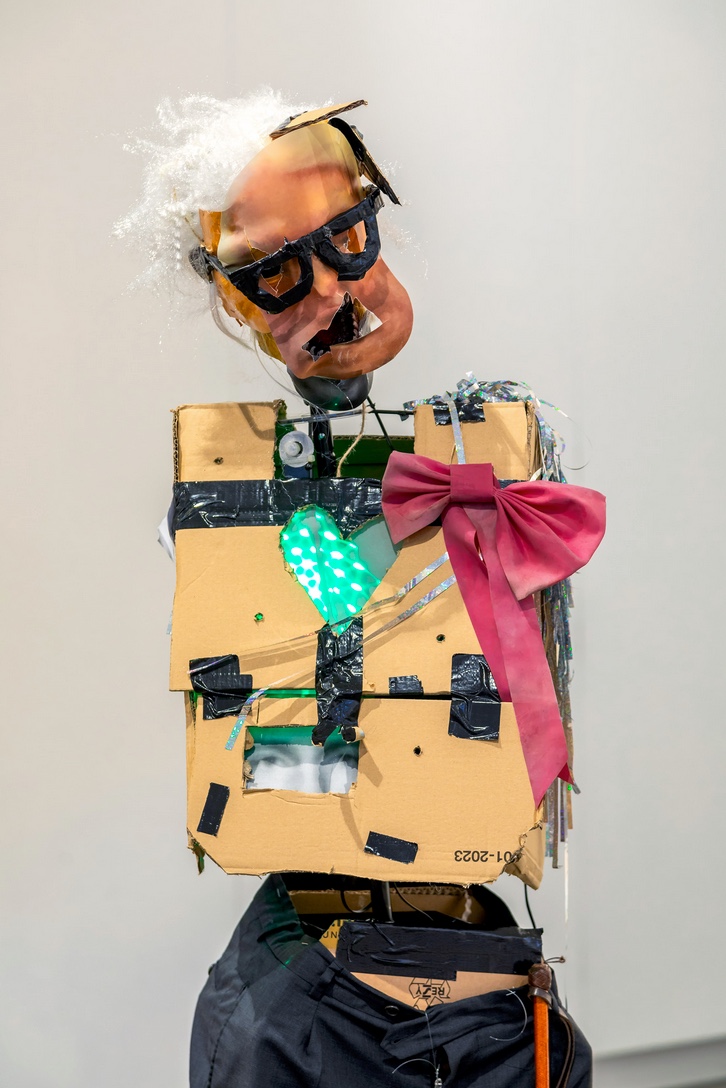
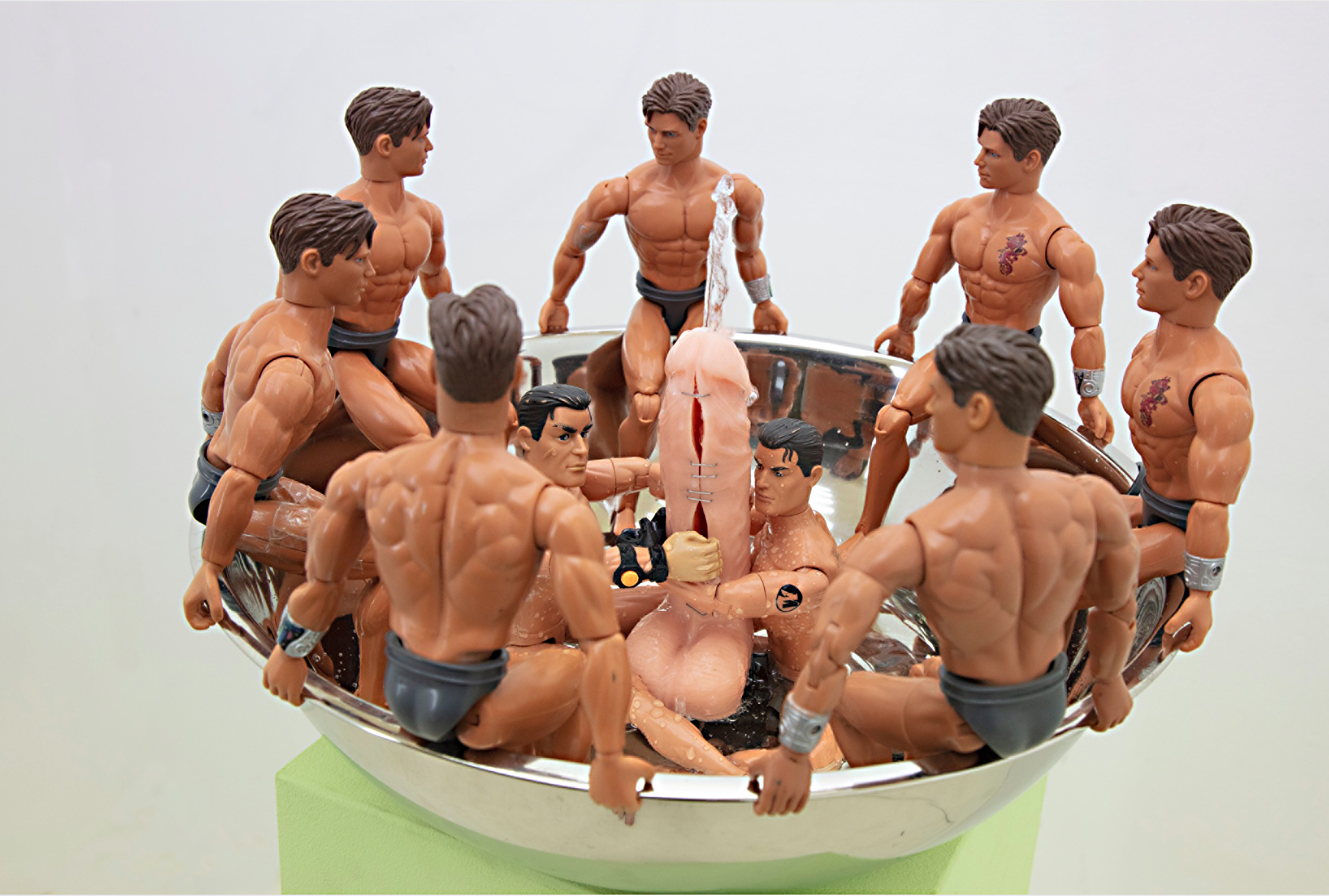

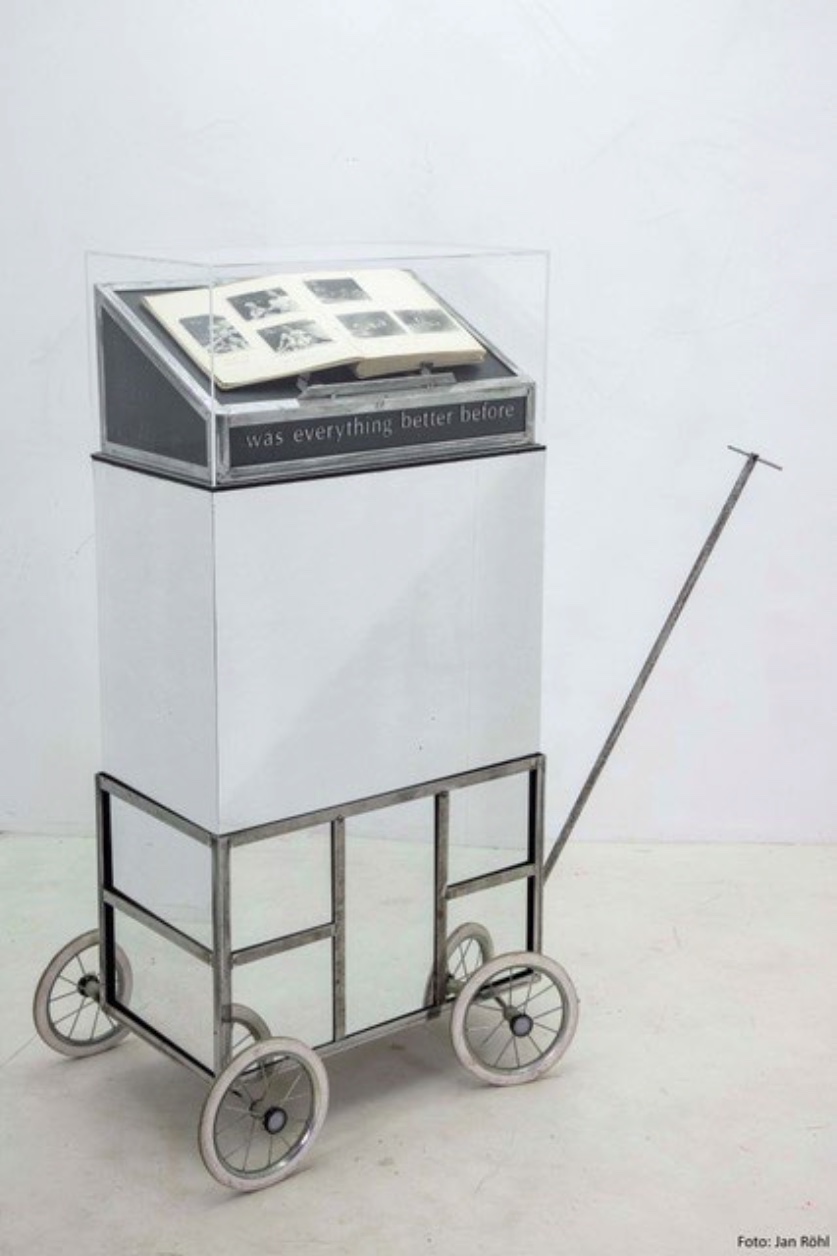
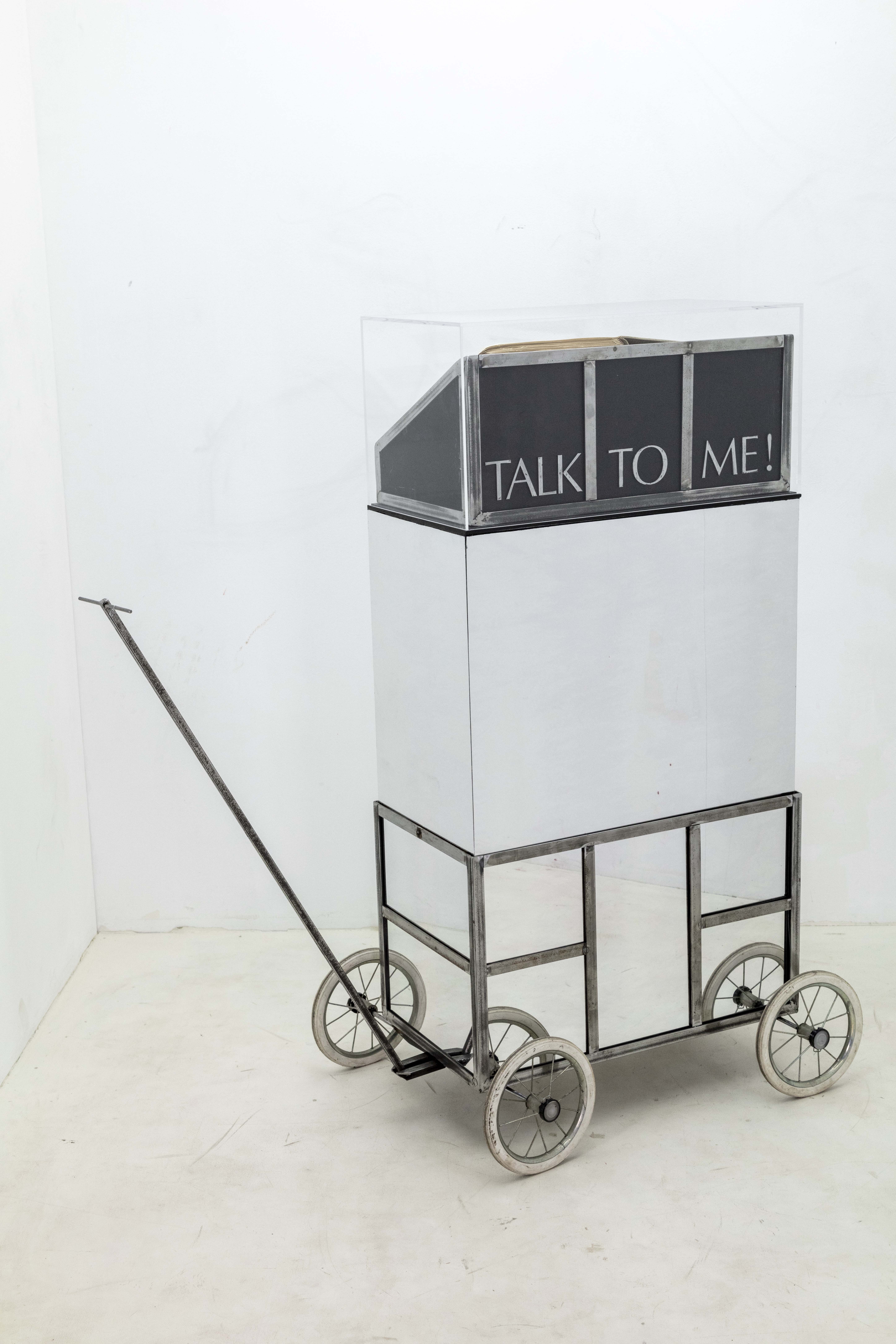
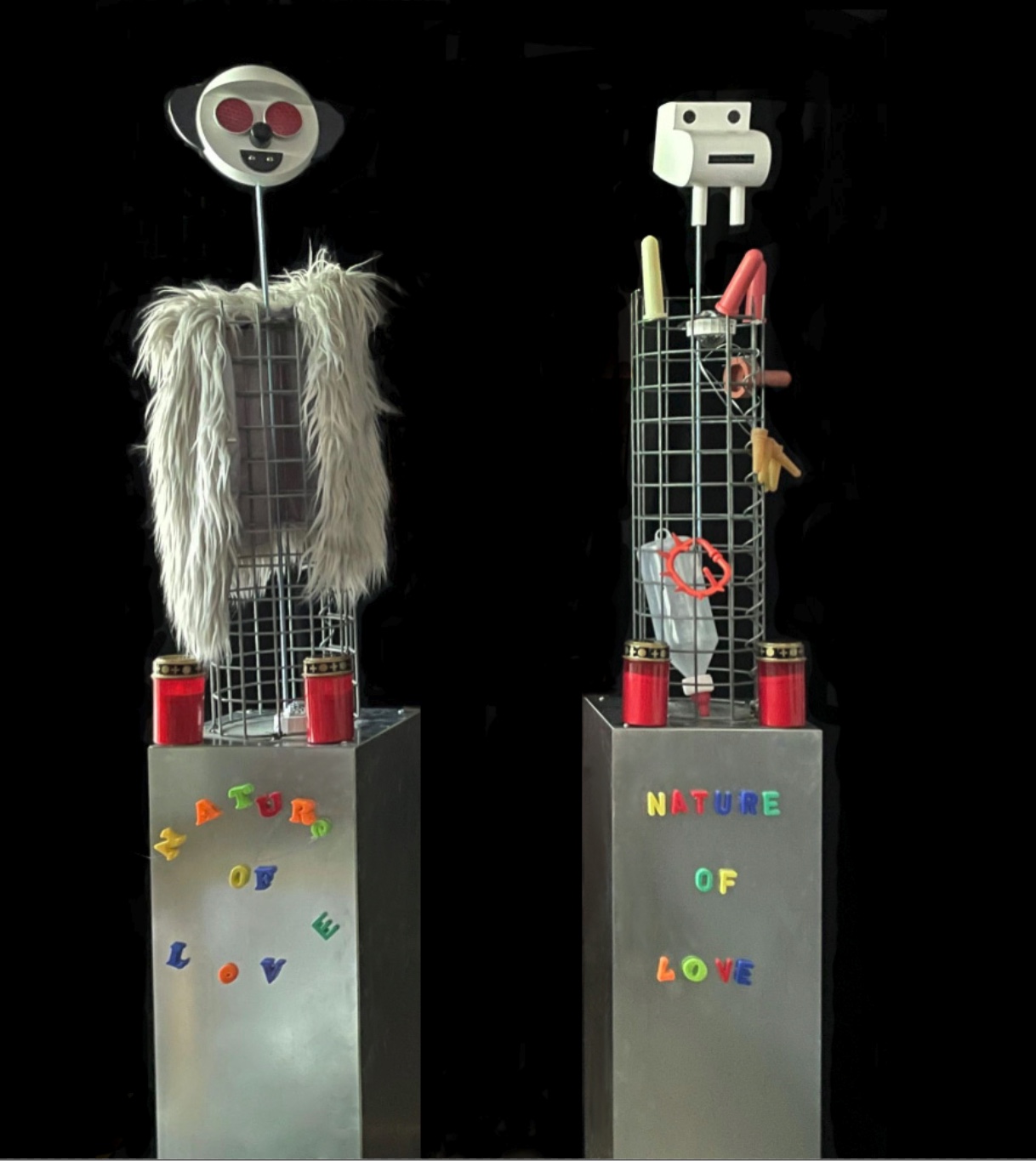
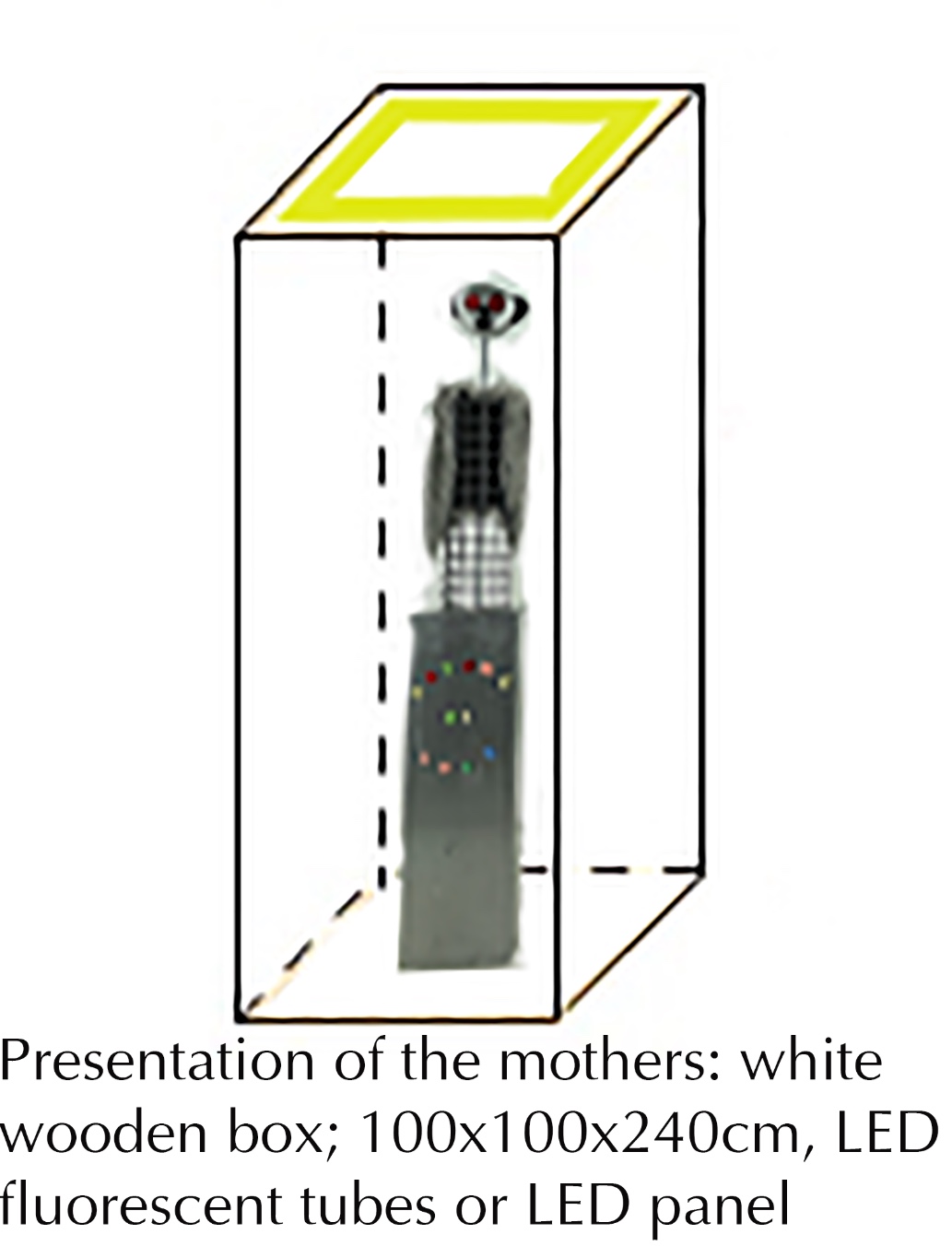
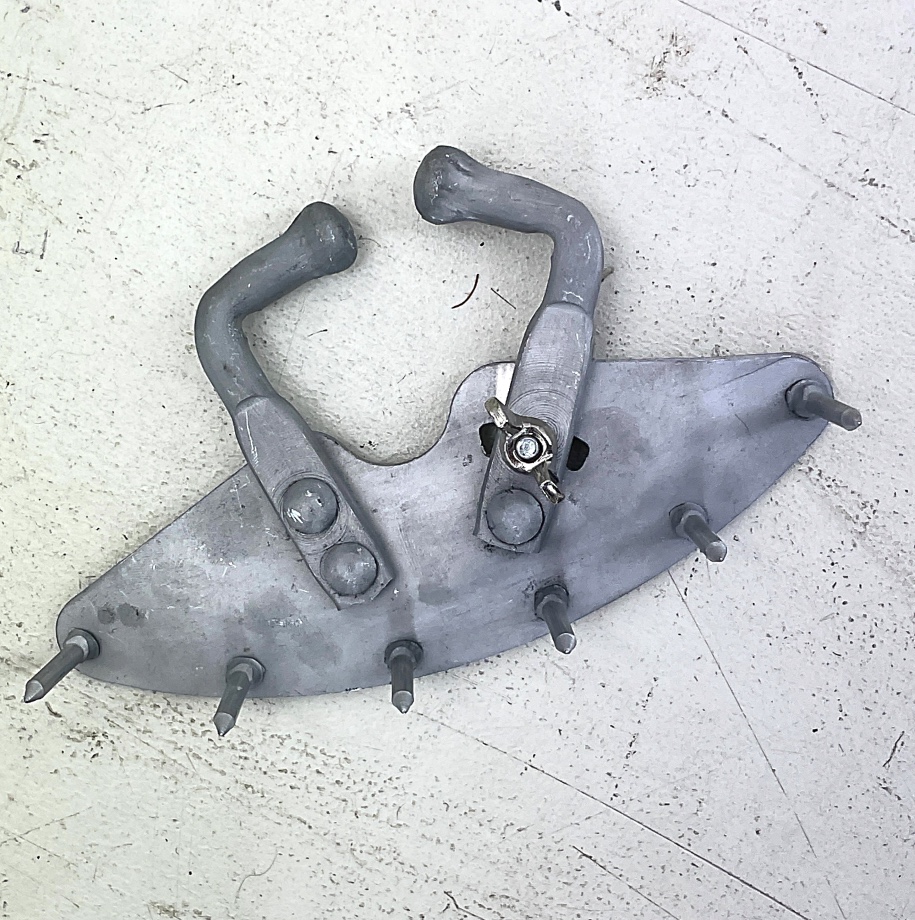
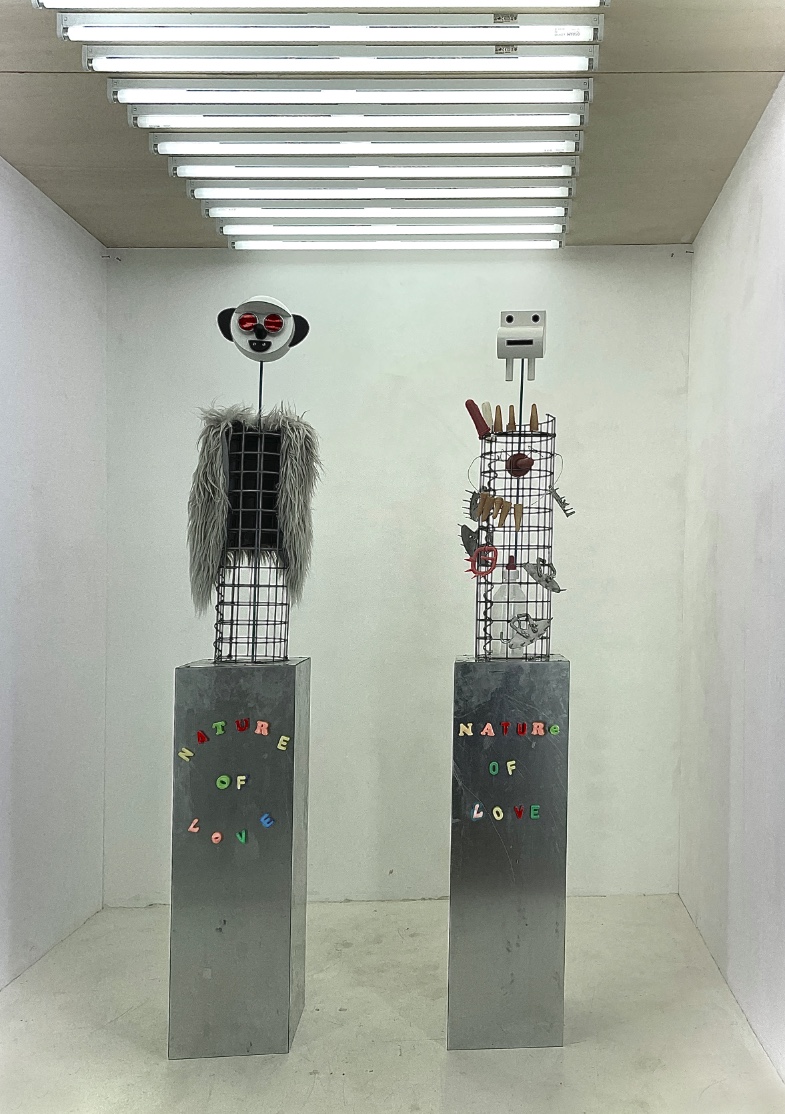



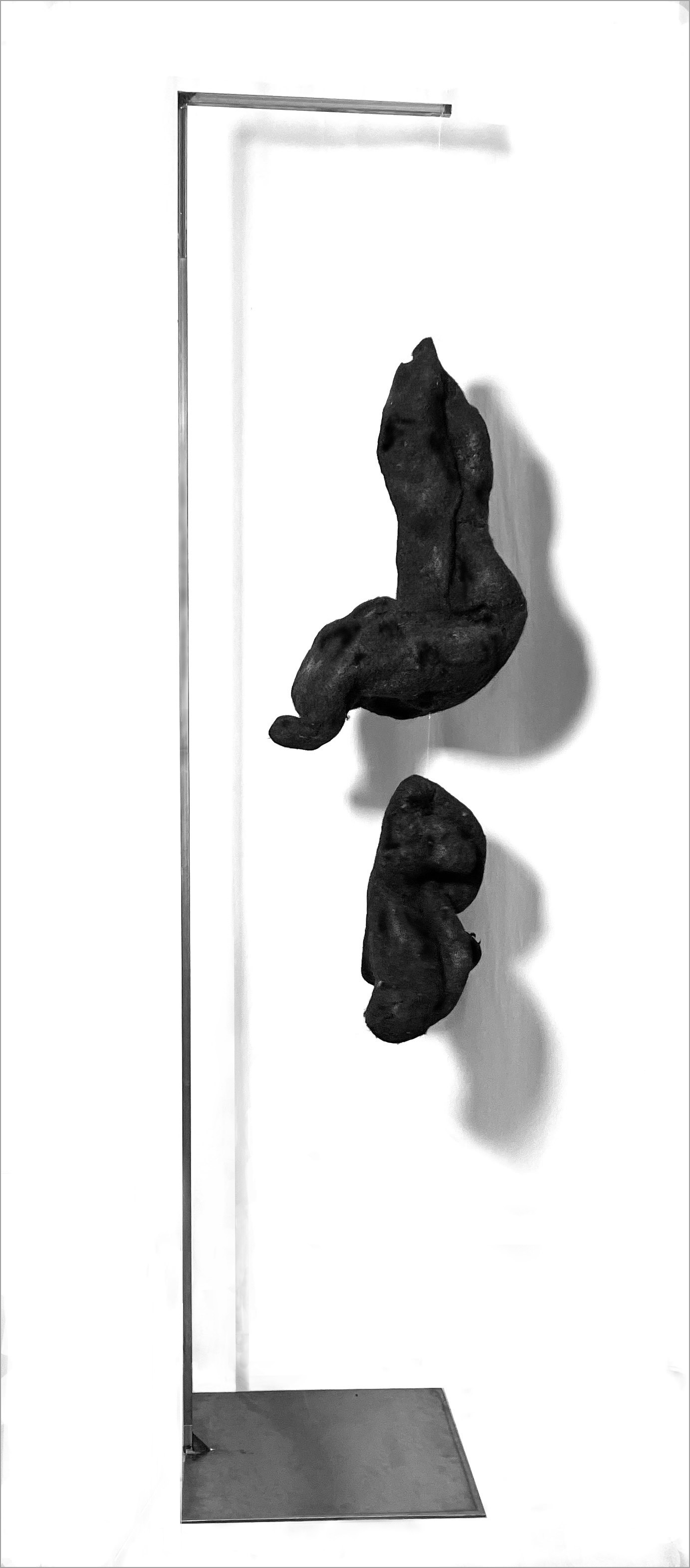
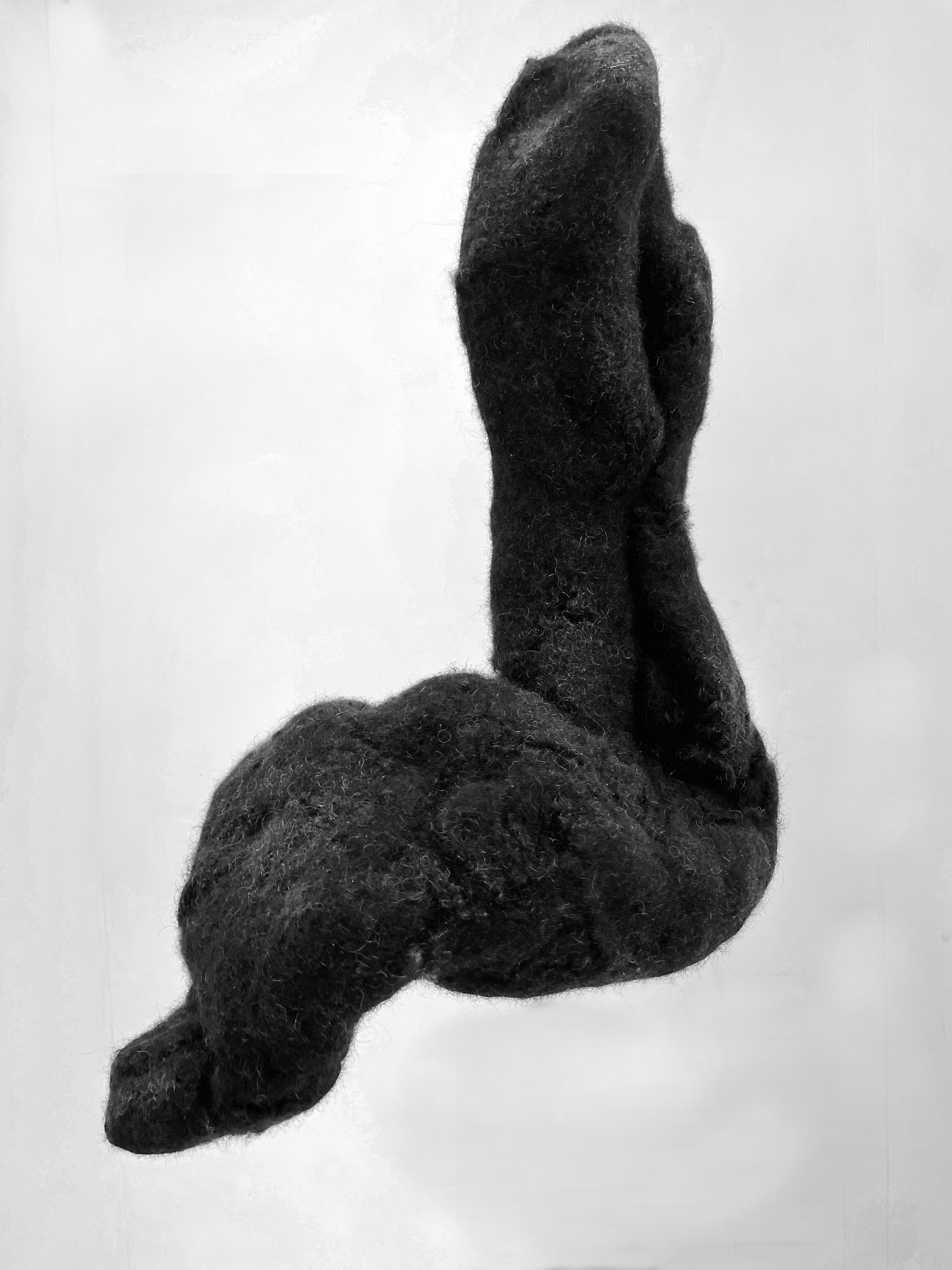
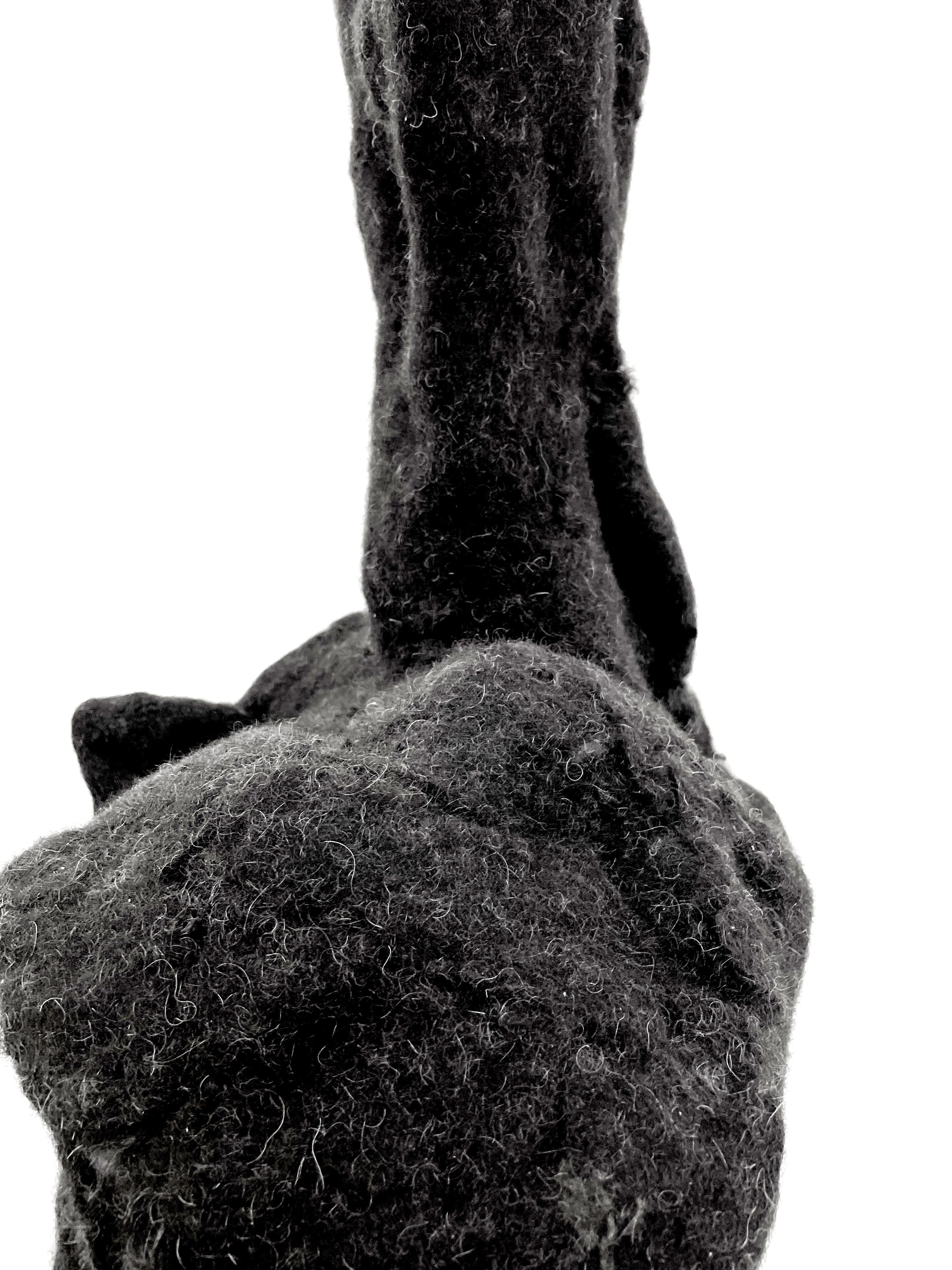
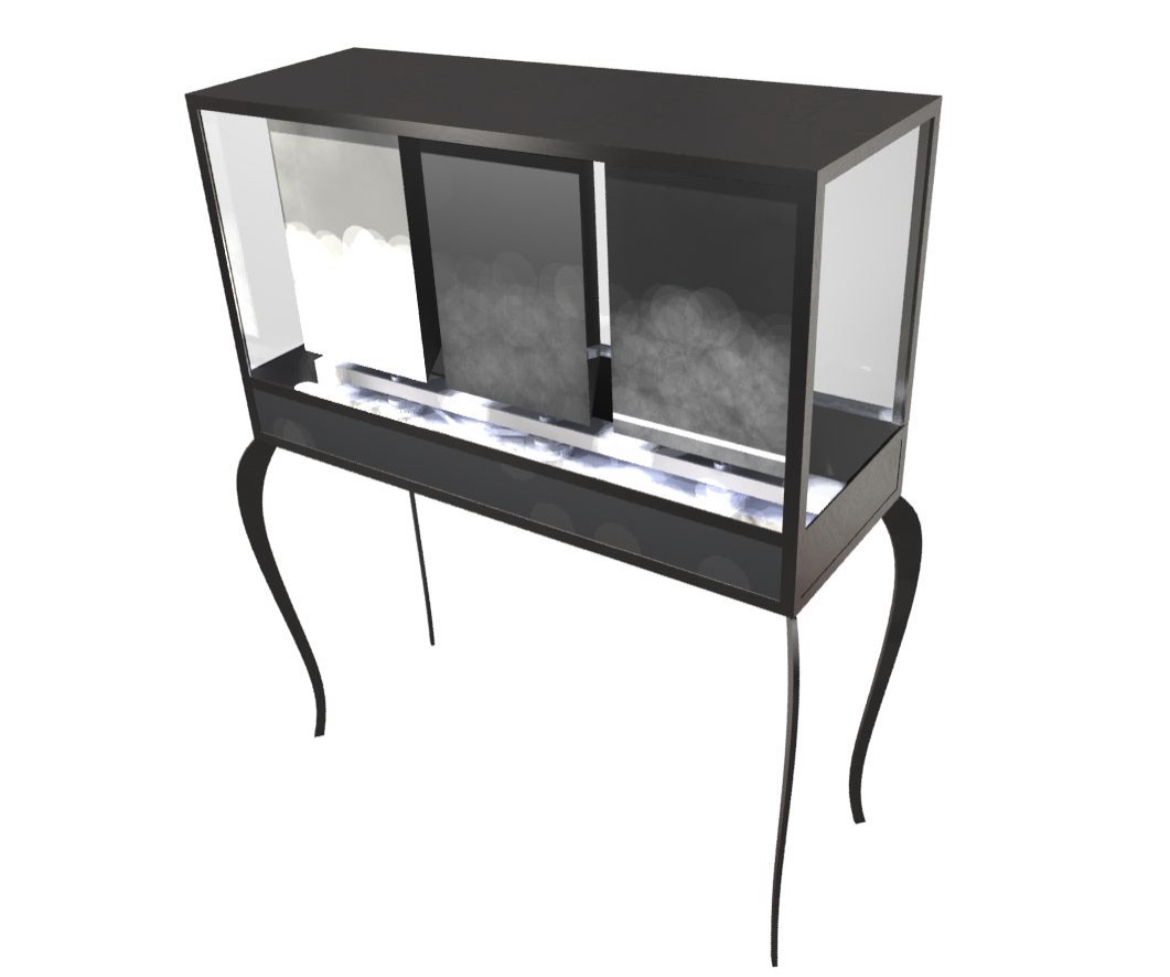
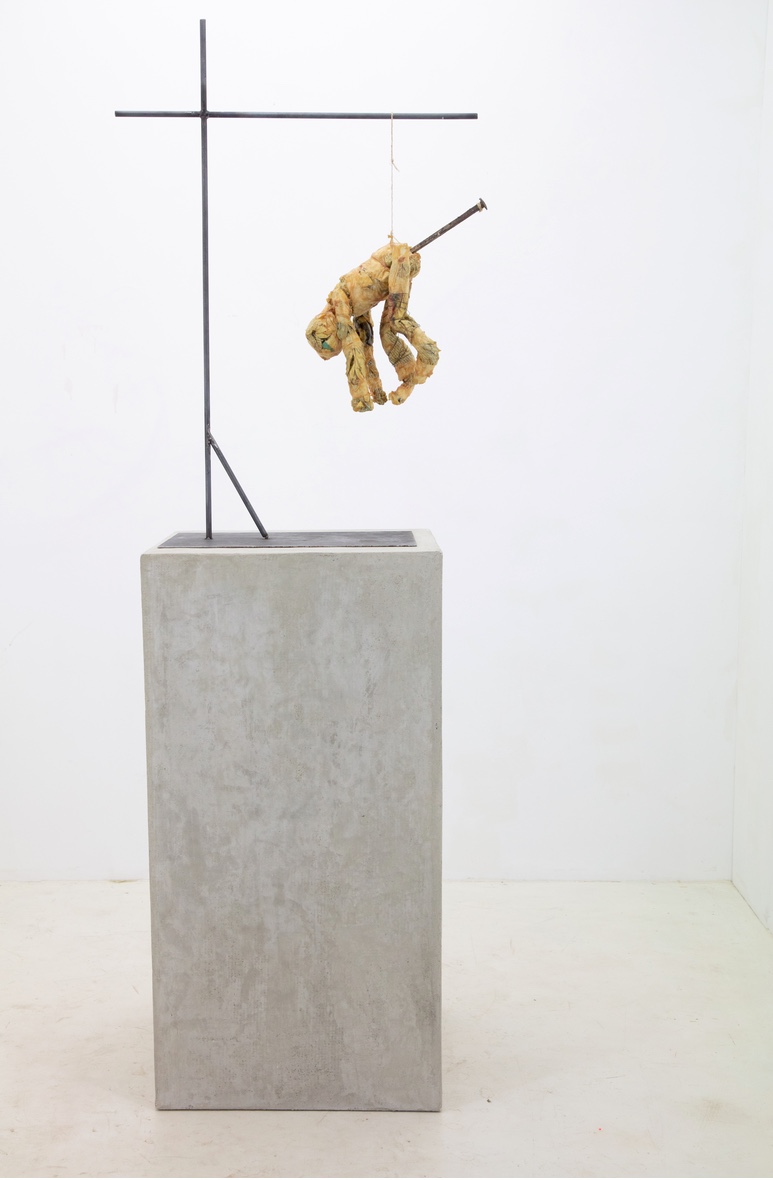
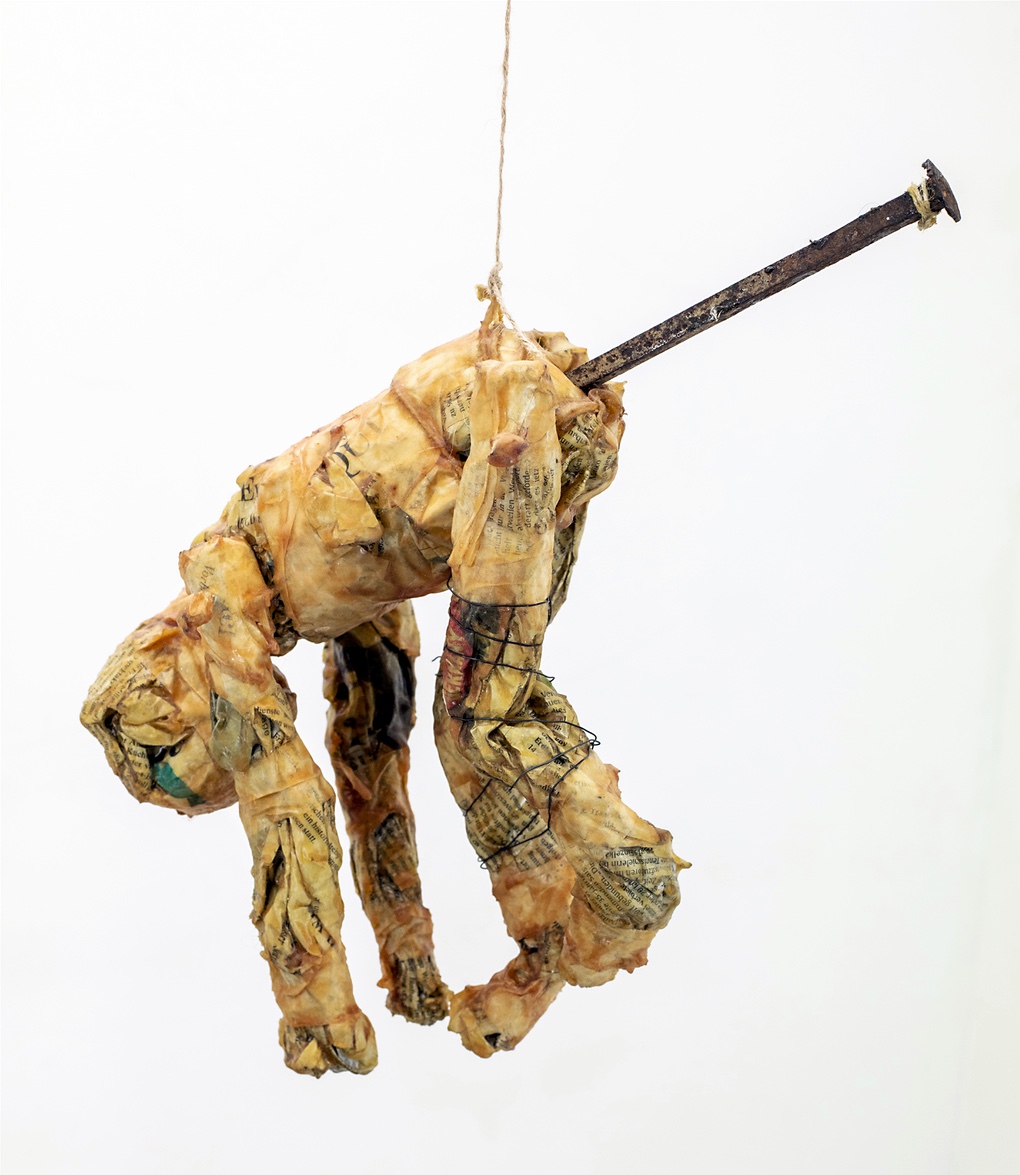

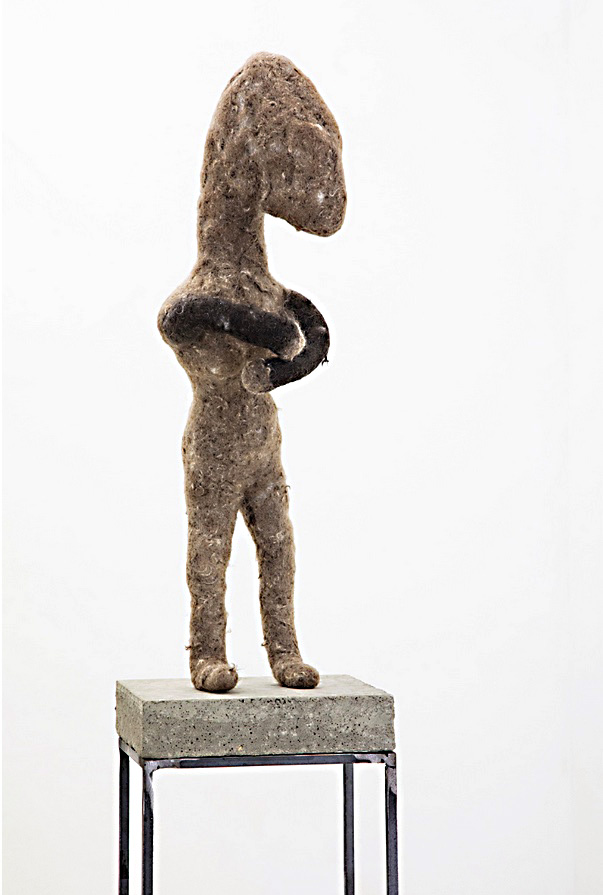
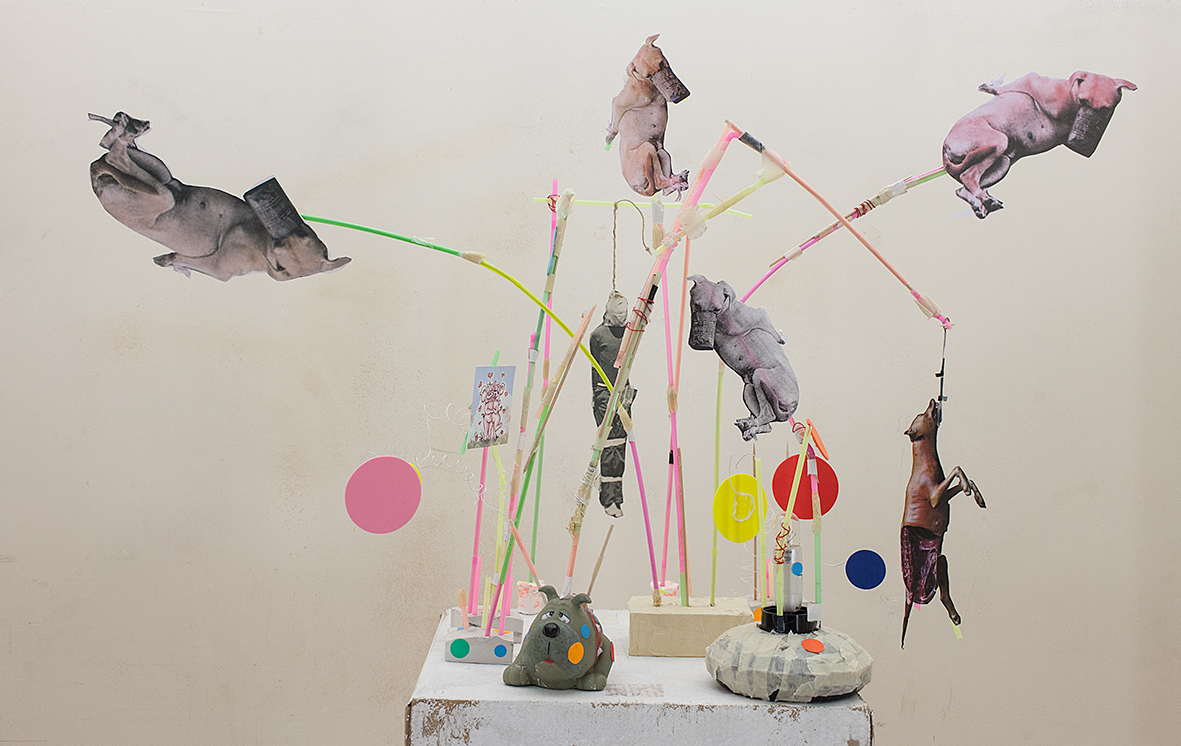
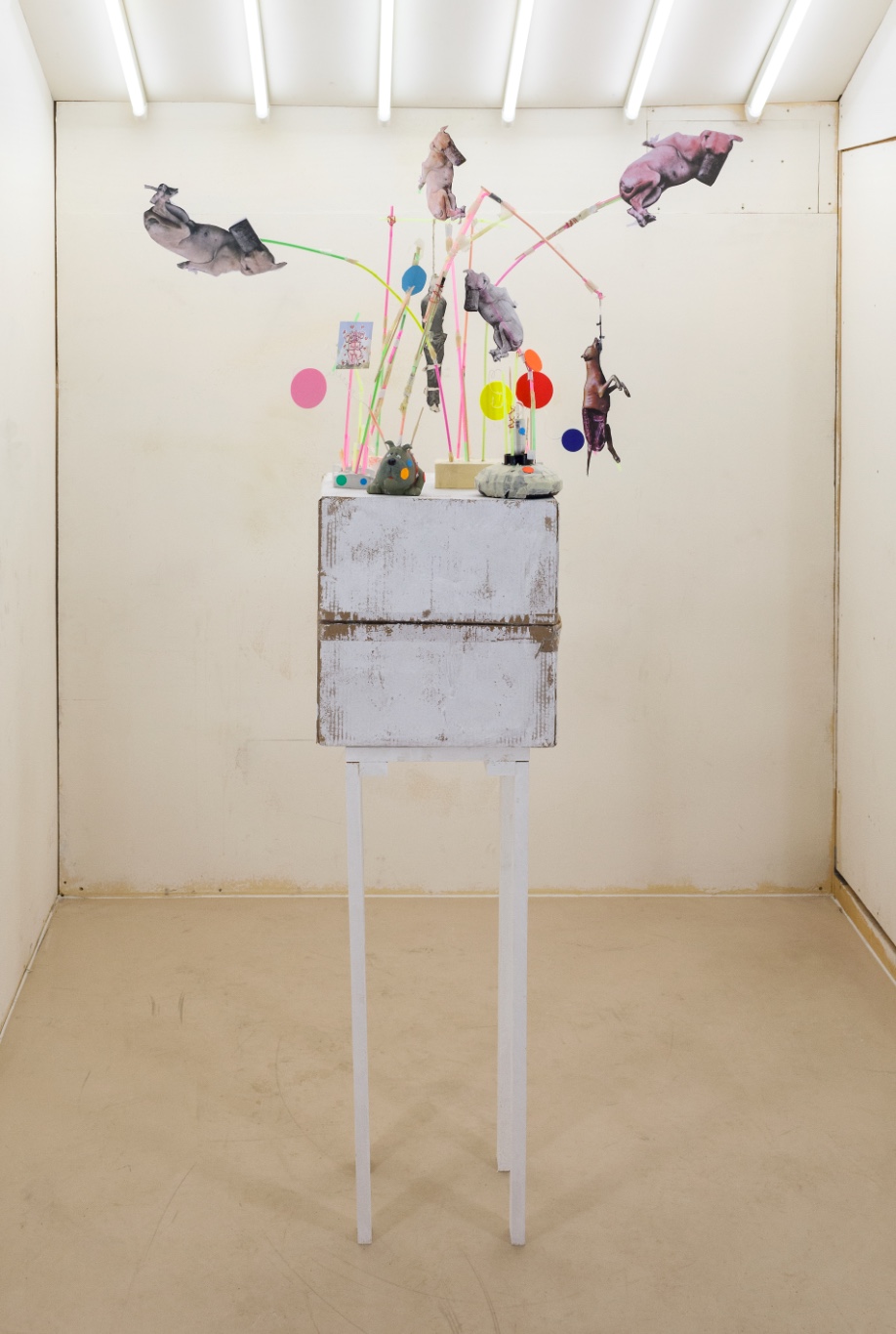
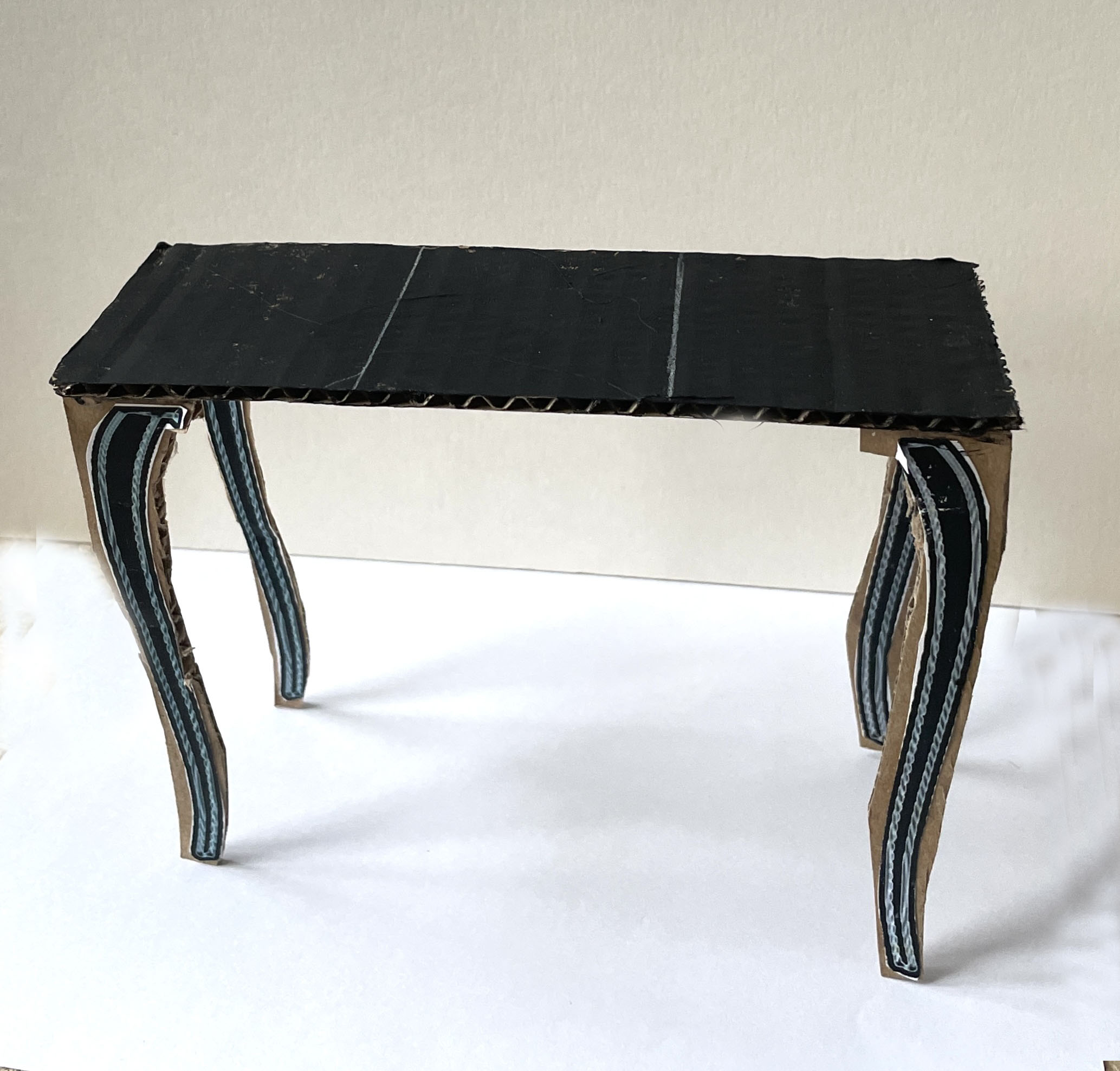
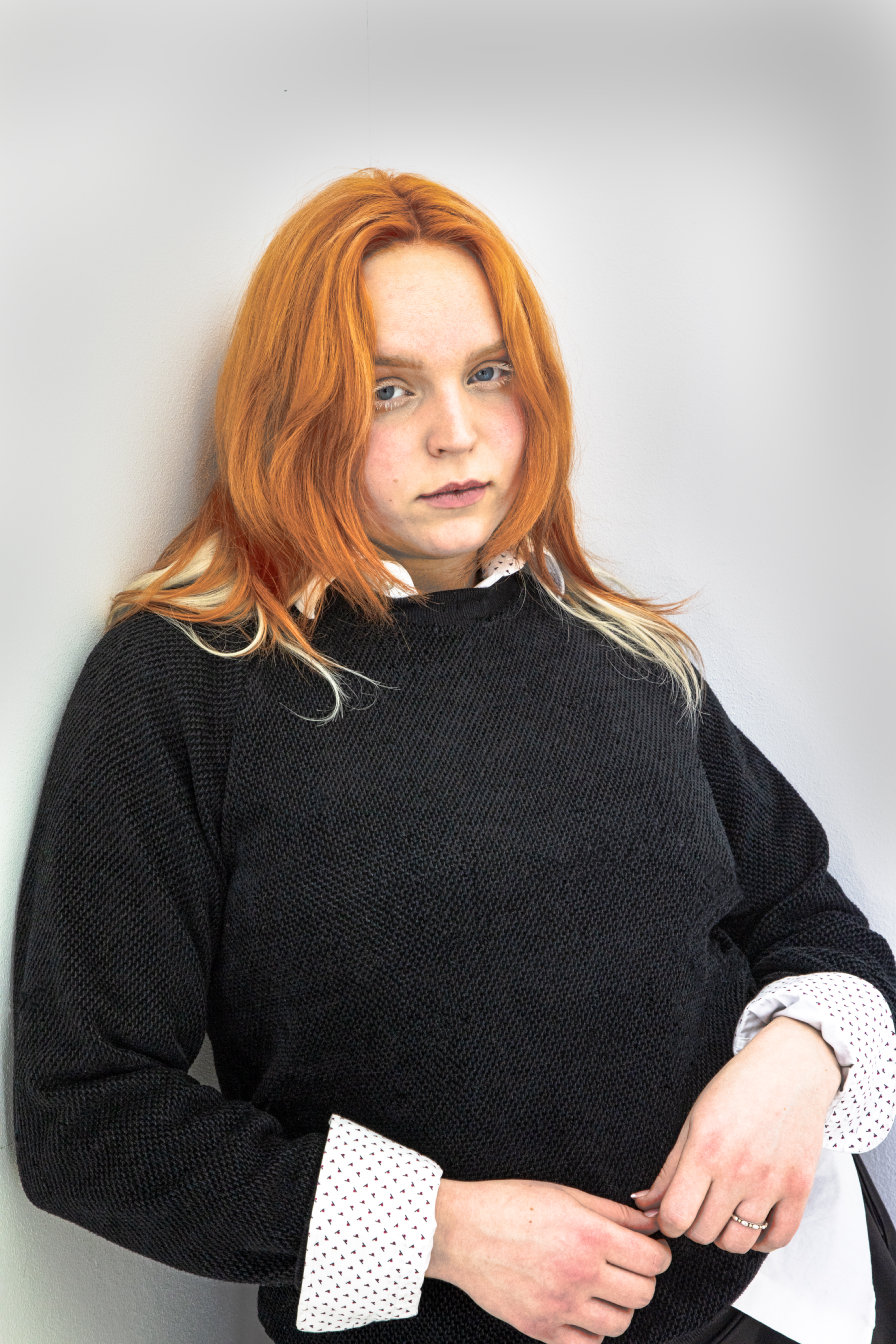
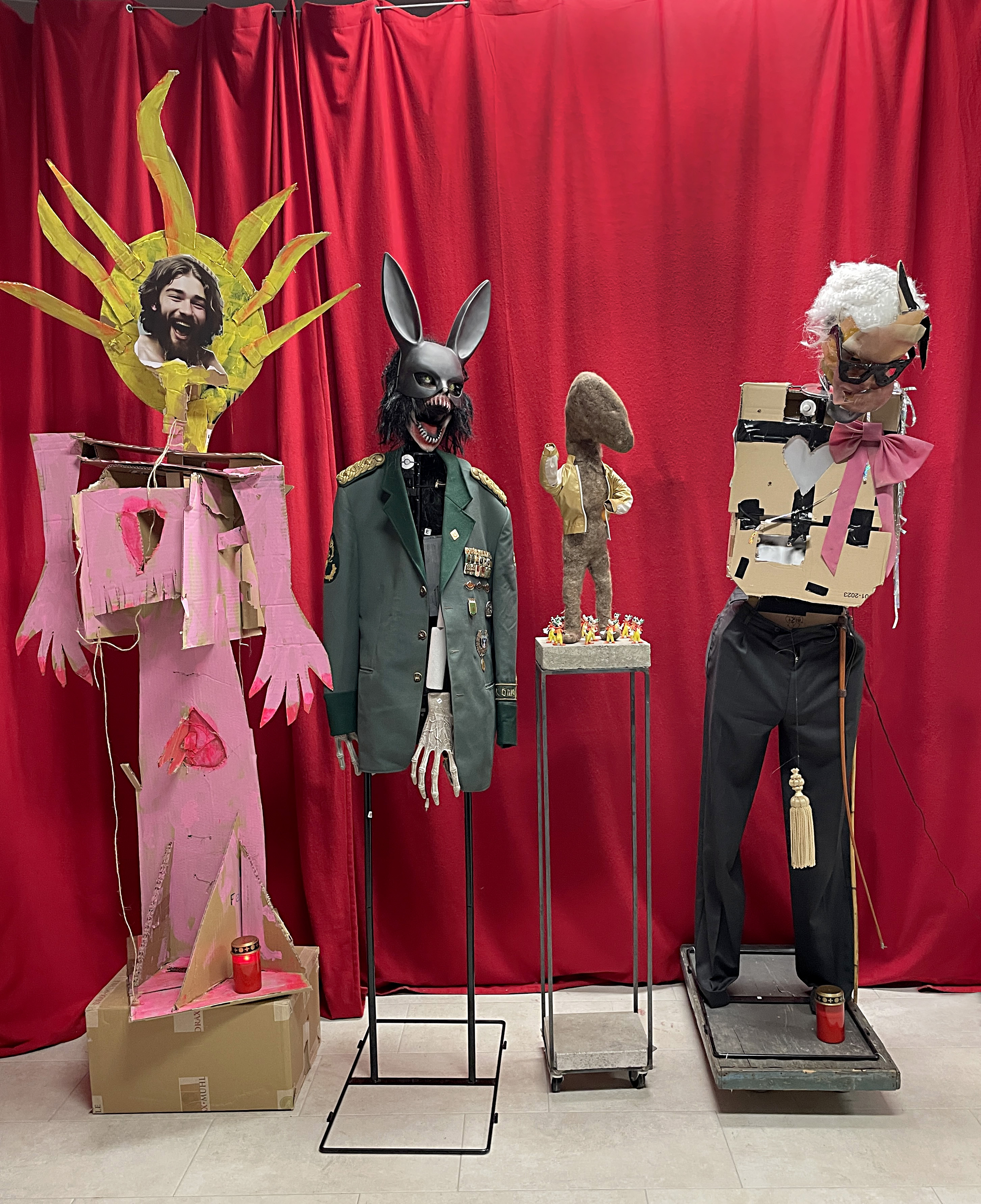
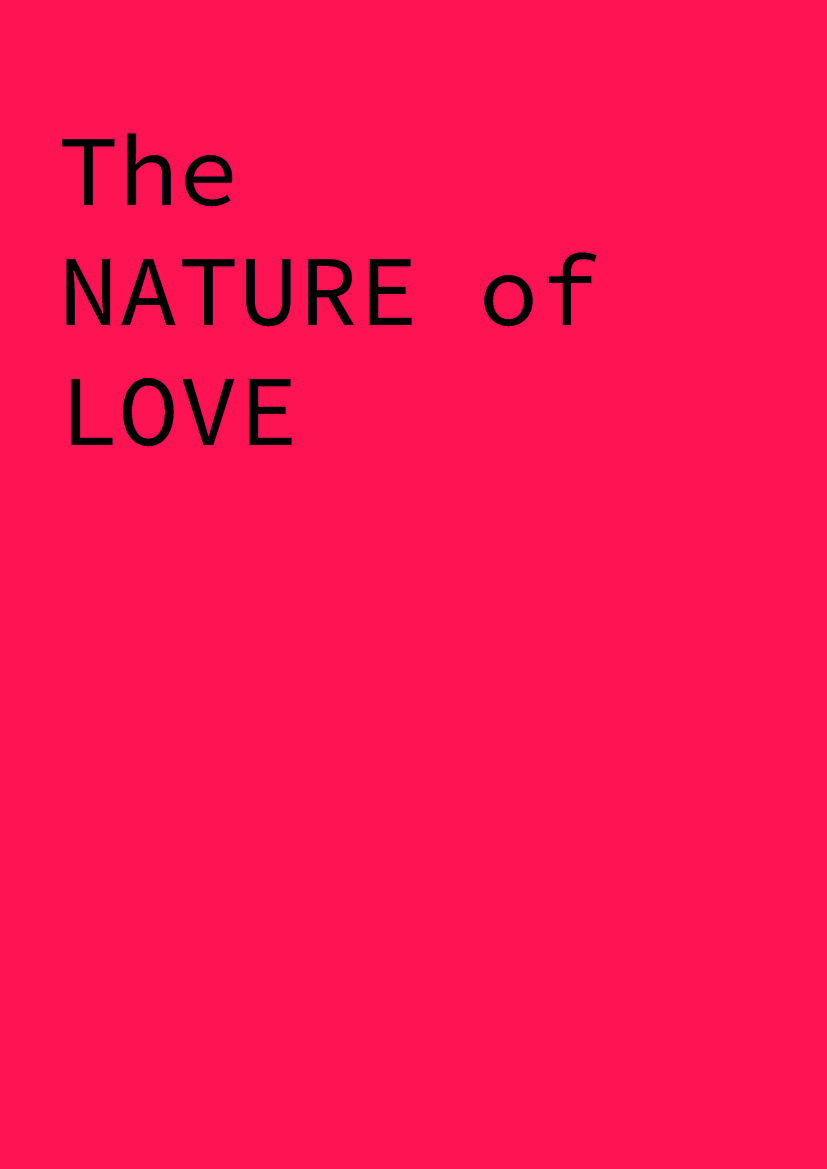
Ingvar (MY LOVE) (2024)
Lebensgroße Skulptur aus Pappe, bemalt. Life-size sculpture made of cardboard, painted (2024)
"Heini" (2023(
Lebengroße Skulptur aus Metall, Plastik, Schützenuniformjacke . Life-size sculpture made of metal, plastic, rifleman's uniform jacket (2023)
"Vater" "Father"
Detail der Installation HASENKLAGE. NATURE OF LOVE. COUNTDOWN. Abschlussarbeit UdK 2023 Detail of the installation HASENKLAGE. NATURE OF LOVE. COUNTDOWN. Final thesis UdK 2023 Animatronic sculpture: screams and moves. Foto: Jan Roehl Berlin
"MENFOUNTAIN" (2022)
8 Actionmen, Metallschüssel, Aquariumpumpe, Dildo. 8 Actionmen, metal bowl, auquarium pump, dildo
"MENFOUNTAIN" (2022)
8 Actionmen, Metallschüssel, Aquariumpumpe, Dildo. 8 Actionmen, metal bowl, auquarium pump, dildo
"TALK TO ME!" (2021)
Metall geschweißt, Metallspiegel, Kinderwagenräder, Schrift (Optima) aus Metallbuchstaben: „TALK TO ME!“ „was everything better before“ h: 127,4 cm b: 63,0 cm l: 82,10 cm Auf einem Handwagen wird das von R. Menkes Mutter in den 1950er Jahren angelegte Fotoalbum mit seinen Kinderfotos gezeigt. Der Handwagen ist geschweißt und mit Kinderwagenrädern aus den 50ern versehen. Der Korpus ist mit Metallspiegeln verblendet. Achse, Deichsel. Geschweißter Aufsatz als Ständer/Stütze für das Fotoalbum. Wird mit dem Handwagen nicht performt, schützt eine aufgesetzte Plexiiglashaube das Fotoalbum. Der Handwagen wird zur Skulptur, zur Vitrine. Zwei Schriftzüge „TALK TO ME!“ und „was everything better before”. Schrifttyp: “Optima” (in den 50er Jahren entwickelte Schrift) Ge- laserte, metallisch glänzende Buchstaben auf geschwärzten Metallplatten. Welded metal, metal mirror, pram wheels, lettering (Optima) made of metal letters: "TALK TO ME!" "was everything better before" h: 127.4 cm w: 63.0 cm l: 82.10 cm The photo album made by R. Menke's mother in the 1950s with his childhood photos is shown on a handcart. The handcart is welded and fitted with pram wheels from the 1950s. The body is covered with metal mirrors. axle, drawbar. Welded attachment as a stand/support for the photo album. If the handcart is not used, an attached plexiglass hood protects the photo album. The handcart becomes a sculpture, a showcase. Two letterings "TALK TO ME!" and "was everything better before". Font: “Optima” (font developed in the 1950s) Lasered, shiny metallic letters on blackened metal plates.
"TALK TIO ME!" (2021)
R. Menke zieht mit dem Handwagen durch die Ausstellungsräume und die Außenanlagen, spricht Besucher*innen an, lässt sich ansprechen. Die Besucher*innen können die Seiten des Albums durchblättern, Fragen stellen, kommentieren, erzählen. Worum es geht: Was passiert, wenn das „Private“, „Intime“, „Einmalige“ der Kindheit im öffentlichen Raum auf Menschen trifft, die nicht zur Familie gehören, aus der die „Familienfotos“ stammen, wo es weder gemeinsamen Erinnerungen noch einen gemeinsamen Bezugsrahmen gibt? Was passiert mit den Bildern, wenn sie von familiären Mythen und Deutungen entkleidet, nackt und gewöhnlich nur noch Fotos sind? Was bleibt vom „Zauber der Kindheit“? Was passiert, wenn durch die betrachtenden Besucher*innen neue Sichtweisen und Perspektiven ins Spiel gebracht werden? Wie sehen sie „den Vater“, „die Mutter“, „die Geschwister“? Welche Rolle spielt der politische Hintergrund – neun Jahre nach Kriegsende: Nazis, Holocaust, Krieg, das Verhältnis von Mann und Mann, Erziehung, Homosexualität etc.? Was ist davon in den Fotos sichtbar? R. Menke pulls the handcart through the exhibition rooms and the outdoor facilities, speaks to visitors and allows himself to be spoken to. Visitors can leaf through the pages of the album, ask questions, comment, tell stories. What it's about: What happens when the "private", "intimate", "unique" of childhood meets people in public space who do not belong to the family from which the "family photos" come, where there are neither common memories nor a common frame of reference? What happens to the images when they are stripped of family myths and interpretations, naked and usually just photos? What remains of the "magic of childhood"? What happens when new views and perspectives are brought into play by the viewing visitor? How do you see "the father", "the mother", "the siblings"? What role does the political background play – nine years after the end of the war: Nazis, the Holocaust, war, the relationship between man and man, upbringing, homosexuality, etc.? What is visible in the photos?
"THE MOTHERS" (2023)
Clothmother ((l) & Wiremother (r) Skulpturen. Höhe insg.: 200cm, Stelen: 30x30x100cm. Metall, gedrechselte Köpfe, Kunstfell, Plastik-Magnet-Buchstaben, elektr. Grabkerzen, div. "Saugentwöhner" und "Kälbersauger". Clothmother ((l) & Wiremother (l) sculptures. Total height: 200cm, steles: 30x30x100cm. Metal, turned heads, artificial fur, plastic magnet letters, electric grave candles, various "sucking weaners" and "calf teats"
Presentation of the "MOTHERS"
Presentation of the mothers: white wooden box; 100x100x240cm, LED fluorescent tubes or LED panel
"Saugentwöhner" Detail "Wiremother" "Sucking Weaner"
"Saugentwöhner" werden in die Nasen der Tierkinder geschraubt und sollen verhindern, dass sie Milch von der Mutter trinken. Die Milch wird verkauft, damit Menschen sie trinken (s. vegan, s. Speziesismus). "Sucking weaners" are screwed into the baby animal's nose and are designed to prevent them from drinking milk from the mother. The milk is sold for people to drink (see vegan, see speciesism)
"CLOTHMOTHER" (l) "WIREMOTHER" (r) (2023)
s. Harry F. Harlow, (1905 -1981) Primatenforscher, schreckliche Experimente mit Affenbabies, Erforschung der "Mutterliebe", "Nature of Love". Harlow verwendete für seine Versuche die "Wire- und Clothmother". See Harry F. Harlow, (1905 -1981) primatologist, horrific experiments on baby monkeys, exploration of "mother love", "Nature of Love". Harlow used the "Wire- and Clothmother" for his experiments.
"WIREMOTHER" (2023)
"CLOTHMOTHER" (2023)
Skulptur. Detail
"MESSER" "KNIVES" (2021)
Rotierende, gebrauchte Messer aus einem Schlachthaus in einem geschweißten Metallkasten. 120 (L) x 60 (B) x 189 cm (H) Metall, Glas, Messer, Samt, Motor, Mechanik. Rotating, used knives from a slaughterhouse in a welded metal box. 120 x 60 x 189cm. metal, glass, knife, velvet, engine, mechanics.
"MESSER" "KNIVES" (2021)
**30 gebrauchte und ausrangierte Messer aus einem Schlachthaus werden in einer mit schwarzem Samt ausgeschlagenen Metallbox gezeigt. Die Messer laufen wie am Fließband an einem Sichtfenster vorbei und erinnern daran, dass in Deutschland jedes Jahr ca. 759 Millionen Landtiere mit solchen oder ähnlichen Messern getötet und zerlegt werden. Rund 8 Millionen Menschen leben in Deutschland vegetarisch bzw. vegan. Davon sind 70% weiblich und unter 30 Jahre alt. Männer essen mehr Fleisch und stoßen mit ihrem Essverhalten ca. 40% mehr Treibhausgase aus. GO VEGAN! Schlachtzahlen: Statistisches Bundesamt 2022 Anzahl Veg./Veg.: IfD Allensbach 2020 Männer essen mehr Fleisch: Online Fachzeitschrift *Plos One“ 2021.
"MESSER" "KNIVES" (2021) Detail
30 used and discarded knives from a slaughterhouse are presented in a metal box lined with black velvet. The knives run past a viewing window like on a conveyor belt, reminding us that around 759 million land animals are killed and dismembered with these or similar knives in Germany every year. Around 8 million people in Germany are vegetarian or vegan. Of these, 70% are female and under 30 years old. Men eat more meat and emit around 40% more greenhouse gases with their eating habits. GO VEGAN! Schlachtzahlen: Statistisches Bundesamt 2022 Anzahl Veg./Veg.: IfD Allensbach 2020 Männer essen mehr Fleisch: Online Fachzeitschrift *Plos One“ 2021
HAIR/FUR (2022/23)
Skulptur. Metall, Draht, Hundehaare (Pudel) H: 230cm, Grundfläche: 30x30cm. untitled Sculpture. metal, wire, dog hair (poodle) H: 230cm, base: 30x30cm
"HAIR/FUR" Detail
Detail
"HAIR/FUR" Detail
Detail
"Vitrine" "Showcase" Entwurf. Draft (2021)
"Vitrine" "Showcase" (2021)
Vitrine mit drei rotierenden Prismen. Metall, Glas, Motor und Mechanik. 150 x 190 x 55cm. Showcase with 3 rotating Prisms. Metal, glass, motor and mechanics.150 x 190 x 55cm.
"NAGEL" "NAIL" (2014)
Zeitungspapier, Draht, Bindfaden, Latex, Nagel. Newsprint, wire, twine, latex, nail.
"NAGEL" "NAIL" Detail (2014)
45 x 28 x 18cm (ohne Stele) (without stele)
Ohne Titel. Untiteled. (2020)
Stoff, Füllmaterial, gefilzte Hundehaare (von Pudel Paul). 70 x 30 x 20cm (ohne Stele) Cloth, padding, felted dog hair (by Pudel Paul).70 x 30 x 20xm (without Stele)
Ohne Titel. Untiteled. (2020)
Stoff, Füllmaterial, gefilzte Hundehaare (von Pudel Paul). 70 x 30 x 20cm (ohne Stele) Cloth, padding, felted dog hair (by Pudel Paul).70 x 30 x 20xm (without Stele)
"EAT ME!"
Detail
"EAT ME!" (2013/14)
„EATME!“, Installation auf Holzgestell und Pappkarton (188cm x 108cm) diverse Materialien: Par- tytrinkhalme, Zahnstocher, Schaschlickspieße, Elektromotor und Glühbirne, Drähte, Klebebänder, Fotos (Tintenstrahl), Hundespielzeug, Papier, Holz etc. Salzburg/Berlin 2013/2014
Tisch table
Tisch mit Barockbeinen aus Pappe, bemalt, Modell: 5,5 (B) x 15 (L) x 10 cm (H) Table with baroque legs made of cardboard, painted, model: 5.5 (W) x 15 (L) x 10 cm (H) (2023)
Sidney Busby - singer and producer based in London, Dezember 2024 Berlin
Ingvar, Heini, Papa
Ingvar, Heini und Papa: lebensgroße Skulpturen aus Pappe, Metall, Kleidung etc. "Justin": aus Pudelhaaren gefilzt, goldene Justin Biber Jacke (70cm) Ingvar, Heini and Papa: life-size sculptures made of cardboard, metal, clothing etc. "Justin": felted from poodle hair, golden Justin Biber jacket (70cm) (2024; 2023; 2020; 2023)